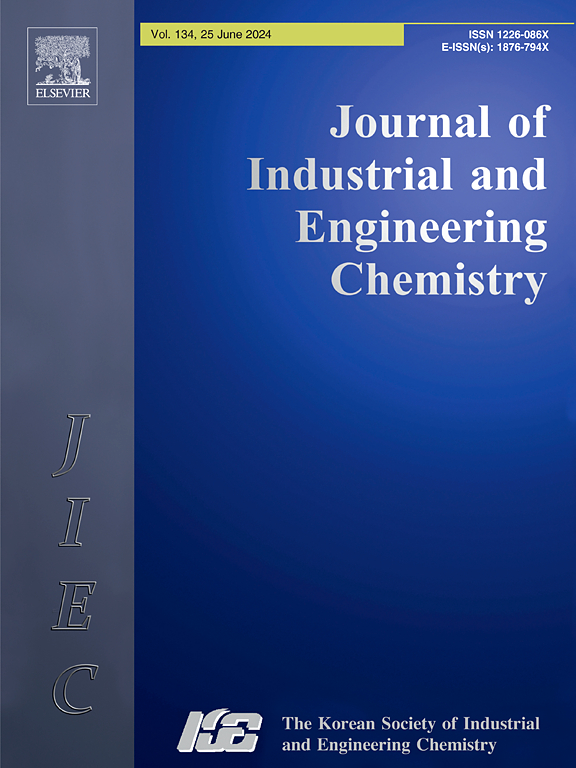Investigation of electrode material and applied current density in molten carbonate electrolysis
IF 5.9
3区 工程技术
Q1 CHEMISTRY, MULTIDISCIPLINARY
Journal of Industrial and Engineering Chemistry
Pub Date : 2025-01-03
DOI:10.1016/j.jiec.2024.12.073
引用次数: 0
Abstract
Molten carbonate electrolysis is a technology that can convert CO2 into valuable solid carbon and oxygen gas. Different materials of electrode pairs are considered in molten carbonate electrolysis, including a titanium cathode and a titanium anode (Ti–Ti), a titanium cathode and a nickel anode (Ti–Ni), a titanium cathode and an Alloy X anode (Ti–Ax), a nickel cathode and a titanium anode (Ni–Ti), and an Alloy X cathode and a titanium anode (Ax–Ti). The electrode pairs are assessed based on their electrolysis performance and characteristics of carbon, which are analyzed using scanning electron microscope (SEM), x-ray diffraction (XRD), and energy dispersive spectroscopy (EDS). The results show that the Ti–Ni pair exhibits the most stable potential performance, the highest Faraday and voltage efficiency, the lowest specific electrical energy consumption, and the fastest carbon deposition rate. Moreover, regardless of the anode, the use of titanium as a cathode results in a spherical onion-like shape, while Alloy X as a cathode produces an amorphous structure with some tubular form.
Based on these results, the effect of the applied current density for the Ti–Ni electrode pair is investigated. The applied current density of 0.1 A cm−2 shows the highest Faraday efficiency of 67.4% and voltage efficiency of 52.3%. It also has the lowest specific electrical energy consumption for a solid carbon product of 25.9 kW h kg−1. The fastest carbon deposition rate is 0.027 g cm−2 h−1, which is obtained by applying a current density of 0.4 A cm−2. The morphology of carbon produced with the applied current density between 0.1 and 0.4 A cm−2 shows a dominant spherical-like onion shape with a larger diameter at a higher applied current density. Furthermore, some tubular forms are found as a result of the applied current densities of 0.2 A cm−2 and 0.3 A cm−2. Plate shapes are also observed, yet only as a result of the applied current density of 0.4 A cm−2. This finding suggests that the applied current density affects the diameter of the carbon particles, but does not significantly change the morphology.

碳酸盐熔融电解中电极材料及应用电流密度的研究
熔融碳酸盐电解是一种将二氧化碳转化为有价值的固体碳和氧气的技术。熔融碳酸盐电解中考虑不同材料的电极对,包括钛阴极和钛阳极(Ti-Ti)、钛阴极和镍阳极(Ti-Ni)、钛阴极和合金X阳极(Ti-Ax)、镍阴极和钛阳极(Ni-Ti)、合金X阴极和钛阳极(Ax-Ti)。利用扫描电子显微镜(SEM)、x射线衍射仪(XRD)和能谱仪(EDS)对电极对的电解性能和碳的特性进行了评价。结果表明,Ti-Ni对具有最稳定的电势性能、最高的法拉第效率和电压效率、最低的比电能消耗和最快的积碳速率。此外,不管阳极是什么,使用钛作为阴极会产生球形的洋葱状结构,而合金X作为阴极会产生一些管状的非晶结构。在此基础上,研究了外加电流密度对Ti-Ni电极对的影响。电流密度为0.1 A cm−2时,法拉第效率最高,为67.4%,电压效率最高,为52.3%。对于固体碳产品,它也具有最低的比电能消耗25.9 kW h kg−1。当电流密度为0.4 a cm−2时,沉积速率可达0.027 g cm−2 h−1。当电流密度在0.1 ~ 0.4 A cm−2之间时,碳的形貌主要表现为球形洋葱状,在较高的电流密度下,碳的直径较大。此外,由于施加的电流密度为0.2 a cm−2和0.3 a cm−2,发现了一些管状形式。板的形状也被观察到,但只是由于施加的电流密度为0.4 a cm−2。这一发现表明,施加的电流密度会影响碳颗粒的直径,但不会显著改变其形貌。
本文章由计算机程序翻译,如有差异,请以英文原文为准。
求助全文
约1分钟内获得全文
求助全文
来源期刊
CiteScore
10.40
自引率
6.60%
发文量
639
审稿时长
29 days
期刊介绍:
Journal of Industrial and Engineering Chemistry is published monthly in English by the Korean Society of Industrial and Engineering Chemistry. JIEC brings together multidisciplinary interests in one journal and is to disseminate information on all aspects of research and development in industrial and engineering chemistry. Contributions in the form of research articles, short communications, notes and reviews are considered for publication. The editors welcome original contributions that have not been and are not to be published elsewhere. Instruction to authors and a manuscript submissions form are printed at the end of each issue. Bulk reprints of individual articles can be ordered. This publication is partially supported by Korea Research Foundation and the Korean Federation of Science and Technology Societies.

 求助内容:
求助内容: 应助结果提醒方式:
应助结果提醒方式:


